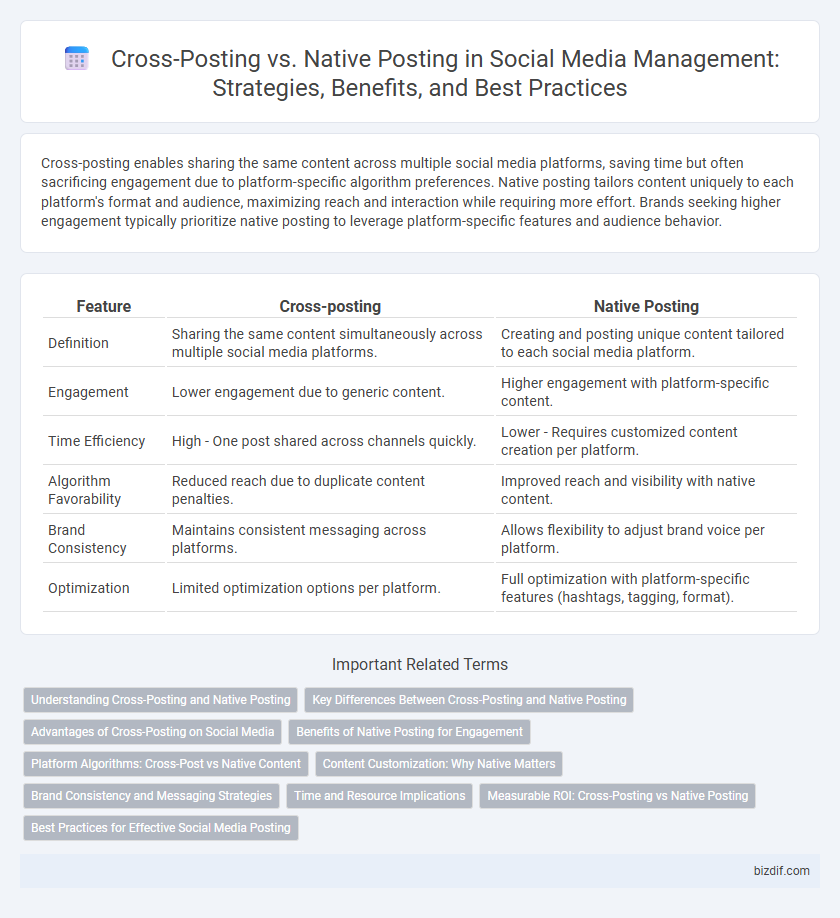Cross-posting enables sharing the same content across multiple social media platforms, saving time but often sacrificing engagement due to platform-specific algorithm preferences. Native posting tailors content uniquely to each platform's format and audience, maximizing reach and interaction while requiring more effort. Brands seeking higher engagement typically prioritize native posting to leverage platform-specific features and audience behavior.
Table of Comparison
| Feature | Cross-posting | Native Posting |
|---|---|---|
| Definition | Sharing the same content simultaneously across multiple social media platforms. | Creating and posting unique content tailored to each social media platform. |
| Engagement | Lower engagement due to generic content. | Higher engagement with platform-specific content. |
| Time Efficiency | High - One post shared across channels quickly. | Lower - Requires customized content creation per platform. |
| Algorithm Favorability | Reduced reach due to duplicate content penalties. | Improved reach and visibility with native content. |
| Brand Consistency | Maintains consistent messaging across platforms. | Allows flexibility to adjust brand voice per platform. |
| Optimization | Limited optimization options per platform. | Full optimization with platform-specific features (hashtags, tagging, format). |
Understanding Cross-Posting and Native Posting
Cross-posting involves sharing the same content across multiple social media platforms, saving time but potentially reducing engagement due to lack of platform-specific optimization; native posting is creating unique content tailored to each platform's audience and features, often resulting in higher interaction and reach. Understanding the differences between cross-posting and native posting is crucial for maximizing social media ROI by balancing efficiency with audience relevance. Effective social media management requires analyzing platform algorithms and user behavior to determine when to employ cross-posting or native posting strategies.
Key Differences Between Cross-Posting and Native Posting
Cross-posting involves sharing the same content across multiple social media platforms, maximizing reach but often sacrificing platform-specific optimization. Native posting tailors content to each platform's unique functionalities and audience preferences, enhancing engagement and algorithmic favorability. The key differences lie in content customization, user interaction, and performance metrics, with native posts generally yielding higher organic reach and interaction rates.
Advantages of Cross-Posting on Social Media
Cross-posting on social media maximizes content reach by sharing the same post across multiple platforms, saving time and resources in content creation. It ensures brand consistency while increasing audience engagement through wider visibility. This strategy also enhances analytics by consolidating performance data, enabling more efficient optimization of social campaigns.
Benefits of Native Posting for Engagement
Native posting boosts engagement by leveraging platform-specific features such as interactive polls, stories, and algorithmic preferences, which increase visibility and user interaction. It enables content to be tailored to the unique audience and format of each social network, leading to higher relevance and authenticity. Analytics from native posts provide deeper insights into user behavior, helping refine future social media strategies for improved engagement.
Platform Algorithms: Cross-Post vs Native Content
Platform algorithms prioritize native content over cross-posted material by favoring posts designed specifically for their unique features and audience engagement patterns. Native posting benefits from higher visibility, increased organic reach, and better interaction metrics due to algorithmic preferences that recognize tailored content. Cross-posted content often experiences reduced distribution and engagement as algorithms detect repetitive posts across multiple platforms, deeming them less relevant or spammy.
Content Customization: Why Native Matters
Native posting enables precise content customization tailored to each platform's unique algorithms and audience behaviors, driving higher engagement and reach. Cross-posting often results in generic content that fails to leverage platform-specific features such as Stories on Instagram or threaded replies on Twitter. Prioritizing native posts enhances visibility and fosters authentic interaction by aligning content style, format, and timing with user expectations on each social network.
Brand Consistency and Messaging Strategies
Cross-posting leverages uniform content across multiple social media platforms, promoting brand consistency by maintaining a singular messaging strategy that reinforces brand identity. Native posting allows tailored content for each platform's specific audience preferences and algorithms, enhancing engagement while preserving core brand messages. Balancing cross-posting with native posting optimizes brand voice uniformity and maximizes platform-specific user interaction.
Time and Resource Implications
Cross-posting saves time by allowing simultaneous content distribution across multiple platforms, reducing the need for individual post creation. Native posting requires more resources as content must be tailored to each platform's format and audience preferences for maximum engagement. Efficient social media management balances these approaches based on available time and resource capacity to optimize reach and interaction.
Measurable ROI: Cross-Posting vs Native Posting
Native posting delivers higher measurable ROI by maximizing platform-specific engagement features and algorithm favorability, resulting in increased reach, clicks, and conversions. Cross-posting saves time and resources but often yields lower engagement rates due to generic content formats and reduced prioritization by social media algorithms. Brands aiming for precise ROI measurement should favor native content tailored to each platform's audience and metrics for more accurate performance tracking.
Best Practices for Effective Social Media Posting
Cross-posting allows content to reach multiple platforms quickly but may reduce engagement due to platform-specific audience expectations and algorithm preferences. Native posting optimizes content for each social media channel, enhancing visibility, interaction, and follower growth by aligning with unique formatting, hashtags, and posting times. Best practices include tailoring messages to each platform's audience, using native tools and features, and analyzing performance to refine posting strategies.
Cross-posting vs Native posting Infographic

 bizdif.com
bizdif.com